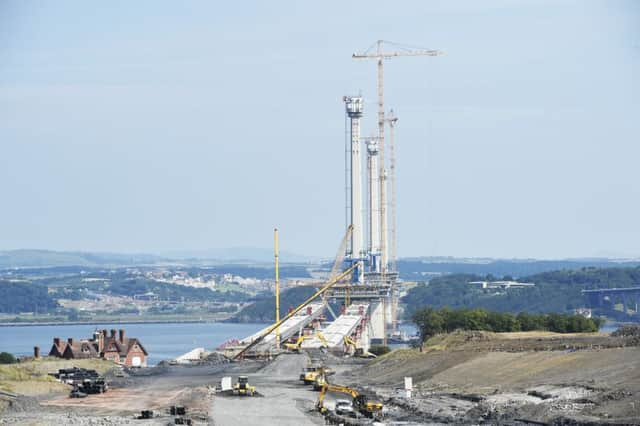Queensferry Crossing is now UK’s tallest bridge


The new bridge’s three main towers have reached some 170 metres high – around 13m above the top of the structure it will replace.
But they still have up to another 36m to go to reach their 207m (683ft) final height.
Advertisement
Hide AdAdvertisement
Hide AdThe towers will then be 50m (166ft) above the top of the Forth Road Bridge – or one quarter higher. That is the equivalent of 55 buses stacked end to end. The Humber Bridge’s 162m towers were the previous highest.
Officials said the project remained on course for completion by the end of next year despite there being previous suggestions it might be finished early.
Infrastructure secretary Keith Brown, who visited the site yesterday, said: “The towers are approaching their final height and are now higher than the top of the Forth Road Bridge, with another 36m to go on the centre and south towers and only 28m to go on the north tower.”
Advertisement
Hide AdAdvertisement
Hide AdThe bridge, just upstream of its 50-year-old neighbour, will take the brunt of its traffic, with the latter reserved for buses and taxis.
The £1.4 billion crossing was ordered by ministers because of corrosion of the main suspension cable on the Forth Road Bridge – which now appears to have been halted – that called into question its life expectancy.
The first four of hundreds of cables which will support the deck of the new cable-stayed bridge have been installed on its north tower. The bridge’s south approach span is also in place, with the north-side one nearly ready to be moved into position this autumn.
Mr Brown said Scottish firms had won nearly half the value of sub-contracts and supply orders so far – £246 million of £549m.
Advertisement
Hide AdAdvertisement
Hide AdHe said: “Significant opportunities continue to be created for Scottish businesses through the wider supply chain.”
However, most of the bridge’s 30,000 tonnes of steel – twice the weight of the world’s largest passenger ship – have come from abroad, including China and Spain.
Mr Brown also said the workforce had reached its expected 1,200 peak. He praised the progress they had made “despite the challenging conditions they often face, particularly in the middle of the Forth estuary”.
The minister added: “Work on the connecting roads has made significant progress this year. The project team have done a great job in mitigating the effects of the recent poor weather and it is pleasing to report the project remains on schedule.”
Labour transport spokesman David Stewart said: “All credit must go to the contractors and workforce who have kept this project on budget and ahead of schedule.”